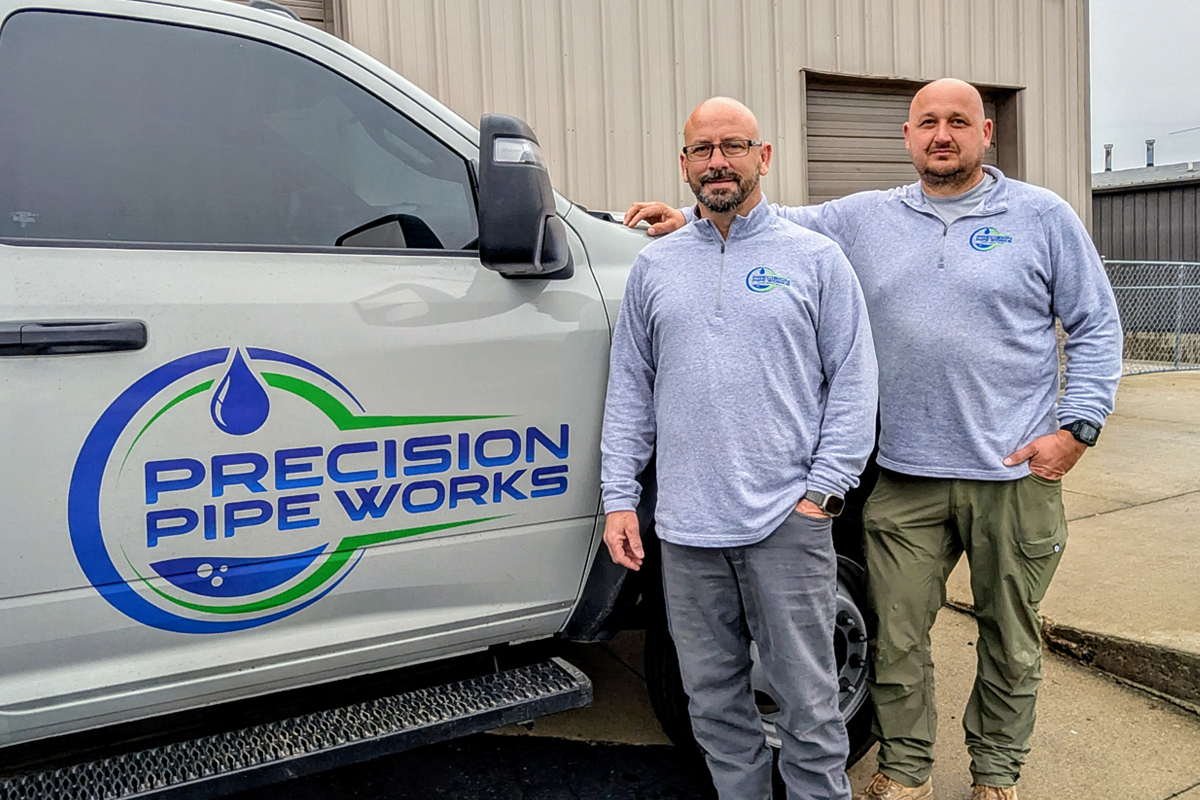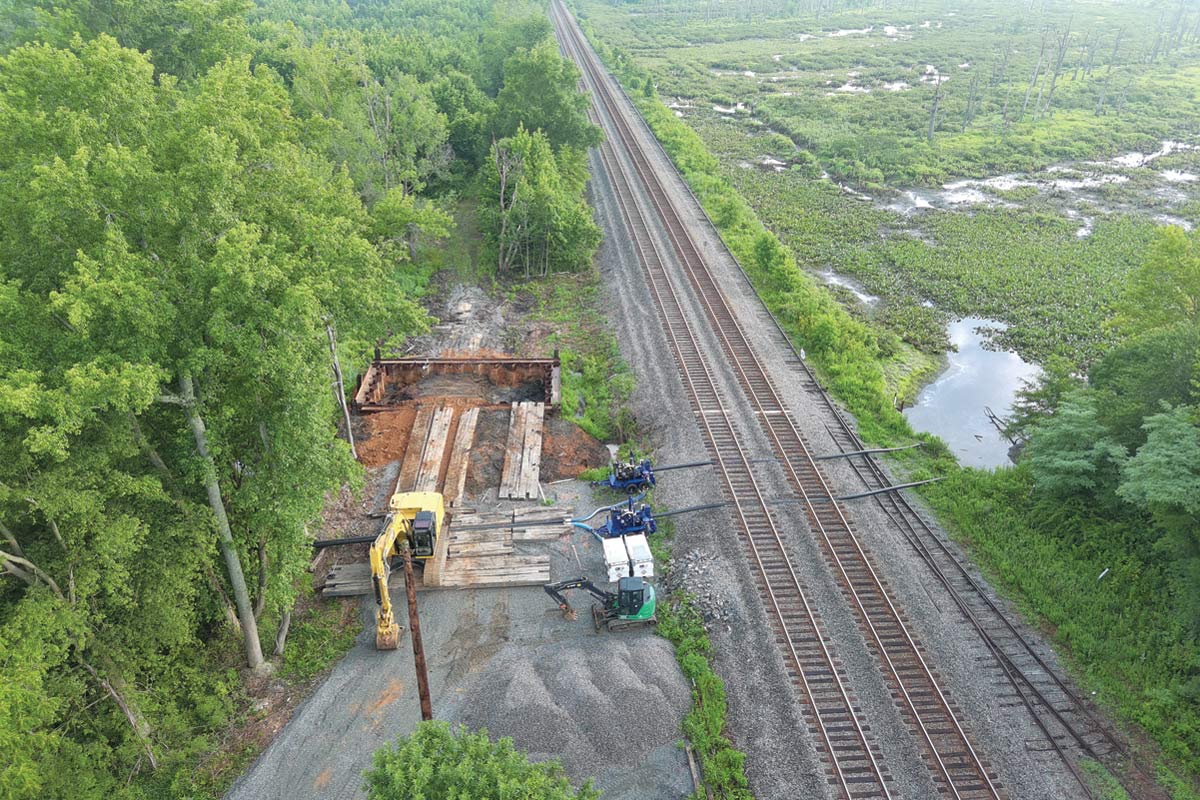
Auger Boring Through Complex Geology
Located just eight miles northeast of downtown Washington D.C., Riverdale Park Maryland is a thriving area with both commercial and residential real estate. A developer interested in constructing a shopping center in the area needed to tie into an existing storm water system, located on the opposite side of a heavily used railroad right of way.
As is typical for more involved crossings, AECOM was hired to represent the rail authority. Aaron Enterprises Inc. (AEI) was hired to bore and jack the necessary 48-in. diameter Reinforced Concrete Pipe (RCP) 88 ft under the freight lines.
RELATED: Taking on Gravity Sewers
Geologically, the area can have a wide range of soil conditions such as sand, silt, clay and gravel. Soil borings indicated a high groundwater table with potential for flowing ground. Because of this possibility, AECOM specified microtunneling as the installation method for the 48-in. diameter RCP. At only 88 ft in length, a true microtunneling method was a costly option.
“The key to this project was finding a cost-effective solution that would address the very realistic concerns of the railroad and AECOM,” said Aaron Enterprises project manager Robert McDowell, P.E.
Working with AECOM, a pilot tube microtunnel method was proposed and approved. The pilot tubes were followed with 36- and then 66-in. diameter steel casings using the bore and jack method.
The 48-in. RCP was installed through the 66-in. casing at the completion of the jacking.

Aaron Enterprises installed 36-in. diameter casing the entire length of the crossing.
The auger and cutter head would be kept behind the transition, approximately 4 ft to assure only material that entered the casing would be removed by the auger. At the completion of the 36-in. installation, the crew welded on a 36- to 66-in. transition.
Project Challenges
In addition to geological concerns, the railroad was limited in its window of inspector availability. Due to a high demand for inspection personnel, AEI was restricted to completing the work during 24-hour operations over weekends only.
The pilot tubes were installed using an Akkerman 240A GBM. The guided pilot tube method displaces the soil during the tube insertion phase. This appealed to the rail authority, which was concerned a conventional auger bore method would cause surface settlement. Elevation change was the primary concern of the owner. There was limited cover under the rails and a hard tie-in elevation on the opposite side of the right of way, which left little room for error. Guided by a theodolite, the GBM operator installed the tubes on exact line and grade.
The steel casing was bored into place using an American Augers 72-1200 boring machine. Because of the diameter, the casing needed to be upsized gradually to keep from damaging the tubes and transition sections.
A 36-in. diameter transition was threaded to the installed pilot tubes. Typically, the transition would be followed with 20 ft of 36-in. steel casing and then a 66-in. transition, but again AECOM raised concern with the potential of subsidence. “The step-up transitions can be stacked, but if the auger is rotating through the transition piece and there is loose material in bore zone, there is exposure for both the rail authority and the boring contractor,” said McDowell.
RELATED: Top Ten Engineering Leaders Continue Upward Trend in Trenchless Design in 2016
It was decided that Aaron Enterprises would install 36-in. diameter casing the entire length of the crossing. The auger and cutter head would be kept behind the transition, approximately 4 ft to assure only material that entered the casing would be removed by the auger. At the completion of the 36-in. installation, the crew welded on a 36- to 66-in. transition.
The first 20 ft of 66-in. casing install posed several problems. First, just beyond the jacking pit, the crew recognized broken pipe being ejected from the bore machine hopper. Standard procedure was followed and the crew shut down the operation to investigate. It was determined the utility was an abandoned water line and the boring was permitted to proceed.
The second obstruction occurred roughly 8 ft in front of the jacking pit. Jacking pressure began to rise and the crew noticed surface heave in the vicinity of the transition. The crew continued another 4 ft with pressure steadily increasing. Concerned the heave may eventually lift the tracks, the crew stopped and notified the onsite rail representative. AEI was permitted to excavate down at the transition as long as the excavation stayed above the rail slope of influence line. Just below the surface, a large tree branch was discovered. The branch had clipped the top of the transition and was being pushed through the ground creating both the pressure increase and the surface heave. The branch was removed and the excavated area backfilled.
The third obstruction was not noticed until a large number of people began to descend on the construction site. At roughly 16 ft into the crossing, the casing encountered a live fiber-optic line. The work crew was in the process of welding on the next length of steel casing when line locators arrived on site to question what our firm was installing. AEI provided the valid utility locate documentation and shared the project plans with the locators. The fiber line was eventually relocated around the bore location.
The remainder of the crossing proceeded without incident. Even with the three delays through the 66-in. steel casing install phase, the work was completed over the course of just two weekends. Concrete Pipe and Precast (CP&P) provided the 48-in. RCP (59.5-in. outside diameter), which was installed through the 66-in. casing supported by structural steel. The annular space between the casing and the RCP was then filled with a cement based grout.
RELATED: Battling the Aging Pipeline Infrastructure Through Sliplining
Even with the latest tools, issues on site are only truly resolved with a knowledgeable work staff that understands the trenchless Industry. The project in Riverdale Park was a success because the work crew was conscious of their surroundings and able to follow a standard protocol when the unknown was encountered. The challenges with construction in highly developed areas seem to increase every year.
Using a combination of the latest technologies are quickly becoming the new normal in underground construction. As methods change and technology advances in the trenchless industry, one cannot forget the foundation of what the industry was built on: auger boring and jacking.
Eric Harlacher is general manager at Aaron Enterprises.




